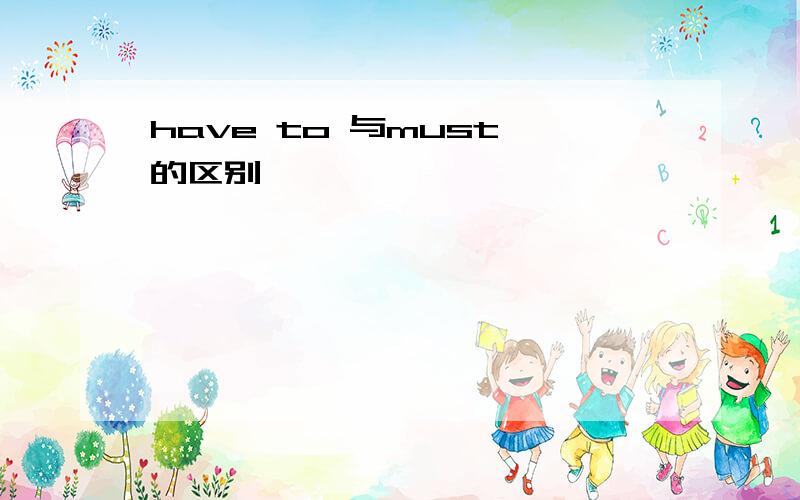have to 与must 的区别
来源:学生作业帮助网 编辑:作业帮 时间:2024/05/04 13:14:24

have to 与must 的区别
have to 与must 的区别
have to 与must 的区别
must表示主观,have to表示客观.
We must help each other.
My sister is ill,my mother has to look after her.
must的用法
1)表示主观的义务和必要,主要用于肯定句和疑问句,意思为“必须……,得……,要……”;由must引起的疑问句,肯定回答要用must或have to,否定回答要用needn’t或don't have to,意思是“不必”;must的否定形式mustn't表示禁止,意思是“不能,不许”.
We must find a good method to learn computer well.
我们必须找一个学好电脑的方法.
2)表示肯定的猜测,常用于肯定句中,意思为“一定是,必然……”.
注意must表示推断或猜测的几种情况:
Your sister must be a doctor in this hospital.(现在的猜测)
你姐姐一定是这家医院的医生.
have to/have got to的用法
1)must表示一种主观的需要,而have to表示一种客观的需要,意思是“不得不”.如:
I have to attend an important meeting this afternoon.
今天下午我不得不参加一个重要的会议.
Mother is out,so I have to look after the shop.
妈妈不在家,因此我不得不照看商店.
2)have to的否定形式是don’t have to,相当于needn’t.如:
They don’t have to buy a computer at present.
他们目前没有必要买电脑.
3)have to与have got to常可以互换.
have to是不得不,must是必须,语气的轻重有差别
1. must表示主观意愿,意为"必须、应该"。例如:
You must attend the class meeting.你应该出席这个班会。
He must return the story-book.他必须将这本故事书还回来。
2.以must引起的疑问句,否定回答通常用needn't或don't/doesn't have to,意为"不必"。例如:
全部展开
1. must表示主观意愿,意为"必须、应该"。例如:
You must attend the class meeting.你应该出席这个班会。
He must return the story-book.他必须将这本故事书还回来。
2.以must引起的疑问句,否定回答通常用needn't或don't/doesn't have to,意为"不必"。例如:
-Must I clean the classroom?我必须打扫教室吗?
-Yes, you must(No, you needn't/No, you don't have to).是的,你必须(不,不必了)。
3. must的否定结构mustn't意为"禁止、不许",语气较为强烈。例如:
You mustn't go swimming today.你今天不许去游泳。
You mustn't drive so fast.不许开得这么快。
4. must可表示有把握的判断或推测,意为"一定、准是",一般用在肯定句中。例如:
He must be a middle school student.他一定是名中学生。
She must live in Beijing.她一定住在北京。
5.在"You must..."句中,它的意思与祈使句相同。例如:
You must come here early.=Come here early!早点来这儿!
You must hurry up!=Hurry up!你必须快点!
6. must与have to都有"必须、应该"的意思。但二者有区别:
1) must侧重于个人意志和主观上的必须,have to则侧重客观上的必须,可译为"不得不"。must与have to经常可以互换使用。例如:
I must/have to go to school now.现在我必须上学了。
2) must可用来表示现在和将来的必须,无时态变化;have to则有更多的时态变化。例如:
He had to give up the plan.他不得不放弃这个计划。
I will have to buy a new pen.我不得不买枝新笔。
3)变否定句时,must只要直接在其后加not,而have to既可变成haven't to,也可变成don't have to/doesn't have to。
收起